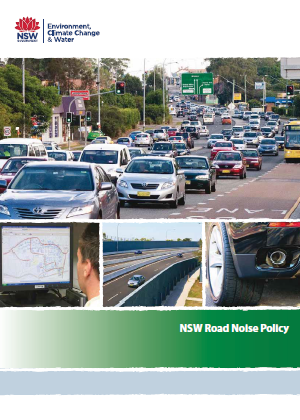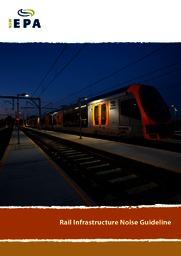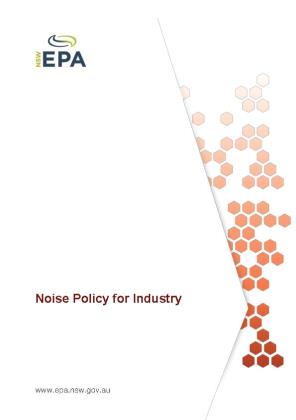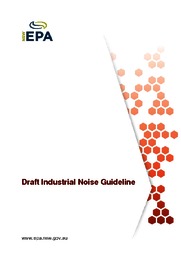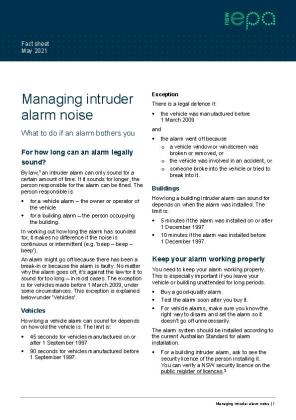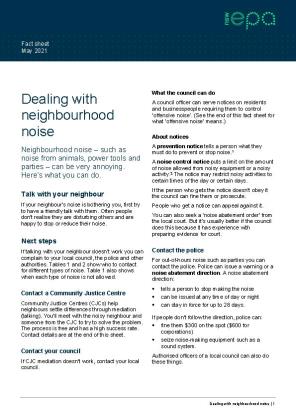Road noise
The EPA has developed a NSW Road Noise Policy (PDF 4.4MB) with other key agencies and industry for
- road project proponents
- determining authorities
- city and transport planners
- acoustic specialists
- people interested in the impacts of road traffic noise
The Road Noise Policy establishes criteria to
- enable roads to be planned and designed to minimise noise during their construction or redevelopment
- reduce traffic noise levels on existing and new roads
- assess the impacts of road traffic noise on the community
- provide information on the Roads and Maritime Service’s Noise Abatement Program, under which residents exposed to acute road noise where no further road developments are proposed may be eligible for assistance with noise mitigation measures
The Road Noise Policy is supported by NSW Road Noise Policy – key provisions (PDF 31KB) and the NSW Road Noise Policy - Application notes (PDF 22KB). They explain the main differences between the policy and the former Environmental Criteria for Road Traffic Noise and how to apply them.
Rail noise
The EPA is working with other agencies, infrastructure owners and developers, rail operators, train manufacturers, regulatory and planning authorities and the community to reduce rail noise and vibration from the NSW rail system. The main goals are to
- implement the Rail infrastructure noise guideline (PDF 556KB)
- implement the environmental planning guidelines for development near rail corridors and busy roads - interim guideline (PDF 4.42MB)
- work with the rail industry on consistent national train noise emission standards
The Rail infrastructure noise guideline
- streamlines approval processes for rail infrastructure projects
- ensures that potential noise and vibration impacts are assessed consistently and minimised as far as possible
- specifies noise and vibration levels for heavy and light rail infrastructure projects
If noise levels are likely to be exceeded while the rail project is under way, the proponent must consider ‘feasible’ and ‘reasonable’ noise mitigation strategies.
Application of noise trigger levels for the redevelopment of heavy rail
The following provides clarity on how to apply the rail noise trigger levels for redeveloped railway projects, as set out in the Rail infrastructure noise guideline (PDF 556KB).
The noise trigger levels for redeveloped heavy rail lines outlined in Table 1 of the guideline must be applied as follows.
Consideration must be given to the noise trigger levels for both the increase to existing rail noise levels and increase to predicted rail noise levels as follows.
The first consideration is whether the development increases:
- existing LAeq(period) noise levels by 2 dB or more, and/or
- existing LAmax rail noise levels by 3 dB or more.
If either or both of these criteria is satisfied (that is, either or both the 2 dB and 3 dB increase occur), it is then necessary to consider the predicted (absolute) rail noise levels.
There are four relevant exceedances for predicted (absolute) rail noise levels that must be assessed. These are, during the day, exceedance of:
- 65 dB LAeq(15h) and/or
- 85 dB LAFmax
and during the night, exceedance of:
- 60 dB LAeq(9h) and/or
- 85 dB LAFmax
When any of the four exceedances in predicted rail noise levels is met, together with either of the increases to existing rail noise levels, the trigger level will have been met and rail infrastructure proponents must evaluate feasible and reasonable noise mitigation measures to manage noise impacts.
Other types of transport noise
For noise enquiries about
- reducing noise from main roads, contact Roads and Maritime Services and their online enquiries
- the construction and operation of local roads, contact your local council
- construction noise near busy roads relating to new residential developments and other buildings such as schools and hospitals, consult State Environmental Planning Policy (Infrastructure) 2007 and Development near rail corridors and busy roads – interim guideline (PDF 4.4MB)


